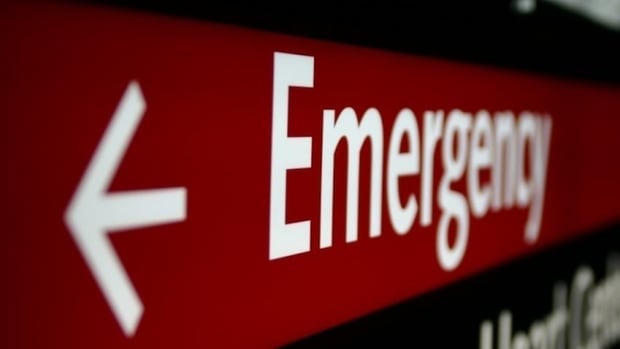New Brunswick·NewMore than 41,000 New Brunswickers walked out of Horizon Health Network hospital emergency departments before receiving treatment in 2024-25, according to a new report by an independent public policy think tank.National group says N.B. has 3rd-highest proportion of walkouts among 9 provincesIn 2024, Horizon recorded more than 320,000 emergency room visits. Of these, 41,236 ended with a patient leaving before receiving treatment, representing 12.9 per cent of all visits, a report from a national public policy organization shows. (CBC)More than 41,000 New Brunswickers walked out of Horizon Health Network hospital emergency departments before receiving treatment in 2024-25, according to a new report by an independent public policy think tank.That represents 12.9 per cent of all Horizon ER visits, compared to a national average of 7.8 per cent — giving New Brunswick the third-highest proportion of patients leaving an ER untreated among the nine provinces included, says the report by the Montreal Economic Institute, known as MEI.Only P.E.I. and Manitoba had higher rates of people leaving without having been treated, at about 14 per cent and 13 per cent, respectively. Ontario had the lowest percentage at just under five.”These patients are not leaving because they feel better, but because the system is failing them,” institute researcher Samantha Dagres said in a statement Thursday.”Thousands of New Brunswickers are being denied access to care each year.”The New Brunswick walkout rates do not include Vitalité Health Network data. The province’s francophone health authority did not respond to a right to information request seeking the data filed by the Montreal Economic Institute in April or numerous follow-up emails, Dagres said.”While the data we received from Horizon doesn’t paint a pretty picture, Vitalité Santé’s failure to respond to our requests for information is especially troubling,” she said. You can’t fix what you can’t measure.— Samantha Dagres of Montreal Economic Institute”You can’t fix what you can’t measure.”Vitalité officials were unable to respond to questions Thursday about why they did not provide their emergency room walkout data to MEI. Nor did they respond to a request from CBC News for the data.Most are semi-urgent, non-urgent patientsHorizon recorded more than 320,000 emergency room visits in 2024. The report says most of the Horizon patients who left untreated were assessed as being level 4 or 5, representing semi-urgent and non-urgent cases.Examples might be a patient with a cut that requires stitches but the bleeding has been controlled (level 4) or a patient needing a dressing changed or a prescription renewed (level 5).Across Canada, one in two patients who left an ER before being treated last year had been classified as a semi-urgent or non-urgent case, according to the MEI report. (Medical-R/Shutterstock)”While these patients do not have the most pressing of medical needs, they still need care, without which their condition may worsen,” the report said.Patients who leave without being evaluated or treated “can underestimate the true gravity of their situation, thus running the risk that their condition will deteriorate,” the report added.”This premature departure can increase the risk of complications, or even death.”Walkouts ‘unacceptable,’ Horizon executive saysHorizon takes the report seriously, said Greg Doiron, the organization’s vice-president of clinical operations.”Every patient who leaves our emergency department without getting care is someone who needed care, and that’s unacceptable to us,” he said.”This is not the kind of health-care system we want.”The report shows the percentage of Horizon patients leaving ERs without being seen has been rising recently, with the exception of a dip in 2023.It was about 9.5 per cent in 2021, jumped to more than 12 per cent in 2022, dipped to just under 12 per cent in 2023 and then increased to 12.9 per cent in 2024-25.That kind of increase reflects a trend nationwide, according to the report, which does not include Saskatchewan data. More than 1.2 million Canadian patients left ERs untreated last year, representing about one in every 13 visits. That’s up nearly 36 per cent since 2019.’Every patient who leaves our emergency department without getting care is someone who needed care, and that’s unacceptable to us,’ said Greg Doiron, vice-president of clinical operations for Horizon, shown here in a file photo. (Government of New Brunswick/Zoom)Doiron said the issue is “multifaceted,” but went on to say one of the biggest challenges involves what are called alternate level of care or ALC patients. That’s the number of people occupying hospital beds while they await a room in a long-term care facility. More than 40 per cent of Horizon’s inpatient beds are currently occupied by patients who “would otherwise get care in [the] community if the appropriate resources existed,” Doiron said, describing that statistic as one of the highest ALC rates in the country.Horizon currently has a year-to-date average of nearly 635 ‘alternate level of care’ patients occupying hospital beds, up from 592 last year, according to its performance dashboard. The health-care network’s target is 330. (Shutterstock)”This has an impact on our ability to provide emergency care because we have many, many patients who end up being admitted and cared for in the emergency department, taking up valuable emergency space, that ultimately limits our ability to provide the necessary access to patients for care when they urgently need it.”Access to primary care a factorDoiron said another factor contributing to the ER walkout rates is the number of New Brunswickers who don’t have a primary-care provider, such as a family doctor or nurse practitioner, and resort to visiting emergency departments instead.Horizon continues to work “aggressively” to create new models of primary care to serve those people, he said.The network is also working with various partners to find solutions to the ALC issue, Doiron said. This includes identifying ways to discharge patients back to their homes or to long-term care placements faster, and finding alternate routes for patients who need less-acute care, such as urgent treatment centres and diversion clinics. [We] feel very strongly that there is a correlation between our ALC rates and our walkouts.— Greg Doiron, Horizon Health NetworkHorizon’s dip in walkout rates in 2023 corresponds with ALC rates and hospital occupancy rates also reaching historic lows, Doiron noted.That happened when the provincial government announced that emergency long-term care beds would be opened using vacant beds in long-term care facilities — primarily special care sites — to help alleviate pressure on hospitals as the COVID-19 pandemic wore on.”That’s why [we] feel very strongly that there is a correlation between our ALC rates and our walkouts,” he said.MEI recommendationsThe Montreal Economic Institute recommends increasing access to what it calls “upstream care.” This includes: Increasing the use of specialized nurse practitioner clinics. Granting the broadest scope of practice to pharmacists, letting them advise people on minor medical matters that family doctors have traditionally handled. Allowing for the creation of non-governmental immediate care medical centres, based on the French model, to treat non-life-threatening emergencies. “Solving the crisis in primary care is essential if we want to keep patients from continuing to fall through the cracks,” Dagres said.”Policymakers must find the political courage to open up health-care delivery to independent and alternative providers, or else this crisis is bound to get worse.”
41,000 New Brunswickers left Horizon ERs before being seen last year, report shows










